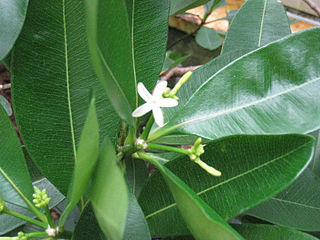
Apocynaceae is a family of flowering plants that includes trees, shrubs, herbs, stem succulents, and vines, commonly known as the dogbane family, because some taxa were used as dog poison. Members of the family are native to the European, Asian, African, Australian, and American tropics or subtropics, with some temperate members. The former family Asclepiadaceae is considered a subfamily of Apocynaceae and contains 348 genera. A list of Apocynaceae genera may be found here.

Ochrosia borbonica is a species of plant in the family Apocynaceae. It is native to Mauritius and Réunion, and naturalized in Guangdong Province in China.

Ochrosia is a genus of flowering plants, first described in 1789. It is in the family Apocynaceae, native to Southeast Asia, Australia, and various islands of the Indian and Pacific Oceans.
- Ochrosia ackeringae(Teijsm. & Binn.) Miq. – Indonesia, Philippines, Papuasia, Christmas Island
- Ochrosia acuminataTrimen ex Valeton - Sulawesi
- Ochrosia alyxioidesGuillaumin - Vanuatu
- Ochrosia apoensisElmer - Luzon, Mindanao
- Ochrosia balansae(Guillaumin) Baill. ex Guillaumin - New Caledonia
- Ochrosia basistaminaHendrian - Sulawesi
- Ochrosia bodenheimarumGuillaumin - Vallée de la Toutouta in New Caledonia
- Ochrosia borbonicaJ.F.Gmel. – Mauritius + Réunion; naturalized in Guangdong
- Ochrosia brevitubaBoiteau - New Caledonia
- Ochrosia brownii(Fosberg & Sachet) Lorence & Butaud - Nuku Hiva in Marquesas
- Ochrosia citrodoraK.Schum. & Lauterb. - New Guinea
- Ochrosia coccinea(Teijsm. & Binn.) Miq. - Maluku, Sulawesi, New Guinea, Solomon Islands; naturalized in Guangdong
- Ochrosia comptaK.Schum., Hōlei – Hawaii
- Ochrosia ellipticaLabill. – Lord Howe Island, Queensland, New Caledonia, Vanuatu, Nauru; naturalized in Guangdong + Taiwan
- Ochrosia fatuhivensisFosberg & Sachet – Fatu Hiva in Marquesas but extinct
- Ochrosia ficifolia(S.Moore) Markgr. - New Guinea
- Ochrosia glomerata(Blume) F.Muell. - Borneo, Sulawesi, Philippines, Maluku, New Guinea, Solomon Islands
- Ochrosia grandifloraBoit. – New Caledonia
- Ochrosia haleakalaeH.St.John, Hōlei – Maui + island of Hawaiʻi in Hawaiian Islands
- Ochrosia hexandraKoidz. - Kazan-retto
- Ochrosia inventorumL.Allorge – New Caledonia
- Ochrosia iwasakiana(Koidz.) Koidz. ex Masam.
- Ochrosia kauaiensisH.St.John, Hōlei – Kauaʻi in Hawaiian Islands
- †Ochrosia kilaueaensisH.St.John, Hōlei – island of Hawaiʻi in Hawaiian Islands, but extinct
- Ochrosia kilneriF.Muell. - Queensland
- Ochrosia lifuanaGuillaumin - Loyalty Islands + Isle of Pines in New Caledonia
- Ochrosia mariannensisA.DC. - Mariana Islands
- Ochrosia mianaBaill. ex Guillaumin – New Caledonia
- Ochrosia minima(Markgr.) Fosberg & Boiteau – Queensland, Papua New Guinea
- Ochrosia moorei(F.Muell.) F.Muell. ex Benth. – Queensland, New South Wales
- Ochrosia mulsantiiMontrouz. – New Caledonia
- Ochrosia nakaiana(Koidz.) Koidz. ex H.Hara - Ogasawara-shoto
- Ochrosia newellianaF.M.Bailey – Queensland
- Ochrosia novocaledonicaDäniker – New Caledonia
- Ochrosia oppositifolia(Lam.) K.Schum. - Seychelles, Chagos Islands, Sri Lanka, Maldive Islands, Andaman & Nicobar Islands, Thailand, Vietnam, W Malaysia, Indonesia, Papuasia, Samoa, Tonga, Tuvalu, Vanuatu, Wallis & Futuna, French Polynesia, Line Islands, Micronesia
- Ochrosia poweriF.M.Bailey - Queensland, New South Wales
- Ochrosia sciadophyllaMarkgr - Bismarck Archipelago, Solomon Islands
- Ochrosia sevenetiiBoiteau - New Guinea
- Ochrosia silvaticaDäniker – New Caledonia
- Ochrosia solomonensis(Merr. & L.M.Perry) Fosberg & Boiteau - Solomon Islands
- Ochrosia syncarpaMarkgr. - Bali, Lombok, Timor, Flores
- Ochrosia tahitensisLaness. ex Pichon – Tahiti
- Ochrosia tenimberensisMarkgr. - Tanimbar Islands
- Ochrosia nukuhivensisFosberg & Sachet = Rauvolfia nukuhivensis(Fosberg & Sachet) Lorence & Butaud
- Ochrosia sandwicensisA.DC. = Rauvolfia sandwicensisA.DC.
- Ochrosia tuberculata(Vahl) Pichon = Rauvolfia sandwicensisA.DC.

Ochrosia fatuhivensis is a species of plant in the family Apocynaceae. It is endemic to Fatu Hiva in Marquesas Islands of French Polynesia.

Ochrosia grandiflora is a species of plant in the family Apocynaceae. It is endemic to New Caledonia. It is threatened by habitat loss.

Ochrosia haleakalae, the island yellowwood or hōlei, is a species of plant in the family Apocynaceae that is endemic to Hawaiʻi. It is threatened by habitat loss.

Ochrosia kauaiensis, the Kauai yellowwood, is a species of plant in the family Apocynaceae. It is endemic to the island of Kauai in Hawaii. It is threatened by habitat loss.
Ochrosia kilaueaensis is an extinct species of flowering plant in the genus Ochrosia in Apocynaceae. Its common names include holei and Hawaii yellowwood. It was endemic to the island of Hawaiʻi. It has been collected only at Puuwaawaa and Kipuka Puaulu and has not been seen since the 1940s.
Ochrosia tahitensis was a species of plant in the family Apocynaceae. It is endemic to Tahiti of the Society Islands, in French Polynesia.

Elatine is one of only two genera in the plant family Elatinaceae, the waterwort family. It contains about 25 species of aquatic plants known generally as waterworts. These are annual or perennial plants found in wet areas worldwide.
Thryptomene hexandra is a shrub in the family Myrtaceae, endemic to Australia.

Manilkara hexandra is a tree species in the tribe Sapoteae, in the family Sapotaceae. It is native to much of south Asia (China: Hainan and southern Guangxi provinces; the Indian Subcontinent: Bangladesh, India, and Sri Lanka; Indo-China: Cambodia, Myanmar, Thailand and Vietnam. Its vernacular names vary regionally; for example "Palu", "Palai" in Tamil or "Rayan" in Sinhalese. It is locally known as the Khirni tree in parts of Bangladesh and India. In the Tamil language it is called Ulakkaippaalai or Kanuppaalai.

Vancouveria hexandra, the white inside-out flower, is a perennial herb in the barberry family Berberidaceae. It is found in southwestern British Columbia, western Washington and Oregon and northwestern California and is a common understory herb in moist, shady Douglas fir forests.

Ochrosia moorei, known as the southern ochrosia is a rainforest plant of eastern Australia. Endangered by extinction, it has a ROTAP rating of 2ECi.

Portlandia is a genus of flowering plants in the coffee family, Rubiaceae. Members of the genus are endemic to Jamaica.

Ochrosia ackeringae is a species of flowering plant in the family Apocynaceae that is found in the Malesian region. The specific epithet honours the collector of one of the syntypes.

Ochrosia elliptica, known as elliptic yellowwood, bloodhorn or kopsia is a flowering tree native to north-eastern Australia, Lord Howe Island and New Caledonia.

Ochrosia oppositifolia grows as a small to medium-sized tree up to 25 metres (82 ft) tall, with a trunk diameter of up to 50 centimetres (20 in). Its flowers feature a creamy to white corolla. Its habitat is coastal forest, bush or open areas to 100 metres (330 ft) altitude, rarely inland. Local medicinal uses include as a carminative and in high doses as an abortifacient. Ochrosia oppositifolia is native to regions from the Seychelles through tropical Asia to the Pacific.
Ochrosia glomerata is a species of tree in the family Apocynaceae.

Leersia hexandra is a species of grass known by the common names southern cutgrass, clubhead cutgrass, and swamp rice grass. It has a pantropical distribution. It is also an introduced species in many regions, sometimes becoming invasive, and it is an agricultural weed of various crops, especially rice. It is also cultivated as a forage for livestock.














